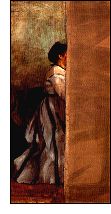
Feature Archive |
| Scandale: The Salons | |
| Revenge: Artimesia Gentileschi | |
| Sittings from Hell: Sargent/Carnation, Lily, Lily, Rose | |
| Private Commissions: Khalil Bey | |
| Rejected Portraits: Kahlo/The Suicide of Dorothy Hale | |
| Villains: Fra Bartolommeo/Savonarola | |
| Surprises: Rembrandt |
Most people don't like the way they look in photographs, and it's not surprising that many sitters are known to have been less than satisfied by painted portraits.

Mary Cassatt painted her cousin, Mrs. R.M. Riddle, in 1885 as a thank-you for the gift of the tea service displayed in the painting. It is a somewhat dour likeness and the nose in particular was major a stumbling block to Mrs. Riddle's enjoyment of the painting, so the gift was refused and sent back to the artist.
Cassatt was long at odds with her family, who didn't seem to value her work or think very highly of a woman having a career at all. Posterity has judged the painting much less harshly, however, and Lady at a Tea-Table is now in the collection of the Metropolitan Museum of Art.
 Cassatt's mentor Edgar Degas, one of the finest portraitists who ever lived, once painted the scene of Manet Listening to His Wife Play Piano (1868). Manet detected "a distortion of his dear Suzanne's features," and cut off her side of the painting in a rage. When Degas saw the vandalism, he seized the painting and stormed out of Manet's home.
Cassatt's mentor Edgar Degas, one of the finest portraitists who ever lived, once painted the scene of Manet Listening to His Wife Play Piano (1868). Manet detected "a distortion of his dear Suzanne's features," and cut off her side of the painting in a rage. When Degas saw the vandalism, he seized the painting and stormed out of Manet's home.One would expect this to lead to all-out war between the painters, both Realists who stayed on the fringes of the Impressionist movement, but the incident eventually blew over. (Degas later asked, How could you expect anyone to stay on bad terms with Manet?) A photograph shows that Degas actually hung the truncated version in his home for a time. He patched the canvas, but never got around to repainting the lost portion.
One of the most famous examples of a painting suffering for its art is Graham Sutherland's Portrait of Sir Winston Churchill (1954). Churchill despised the work and never allowed it to be displayed. Much later, Sutherland discovered that Lady Churchill had burned the portrait shortly after the former British Prime Minister's death.
I look as if I was having a difficult stool, complained Churchill, and although there was great public outcry against "Lady Churchill's Revenge," it must be admitted there is some truth to the statement. Surviving photographs of the portrait show the focus of the painting to be on Churchill's crotch and belly, as if seen from slightly below eye-level, and the pose does indeed have a vague sitting-on-the-toilet feel to it.
But the prize for having provoked the most outrage with a portrait would probably go to Frida Kahlo. She was a friend of Dorothy Hale who, after the death of her husband and a subsequent string of failed romances, committed suicide by leaping from the window of her New York City apartment.
Clare Booth Luce, the famous writer and socialite who was also a close friend of Dorothy Hale, subsequently met Kahlo and commissioned her to paint a portrait of Hale. Luce was doubtless expecting some kind a conventional over-the-fireplace portrait, but the ever-morbid Kahlo's The Suicide of Dorothy Hale is a lurid and bloody scene showing Hale falling to her death, and also lying dead on the pavement below.
Luce, beside herself with astonishment and rage, was restrained from having the death portrait destroyed but did have the most offending portions painted over.
Additional Resources:
Click here to read more about The Suicide of Dorothy Hale
| Continue to next page: Villains |
This article is copyright 2000 by John Malyon. Please do not republish any portion of this article without written permission.
John Malyon can be contacted at jmalyon@artcyclopedia.com